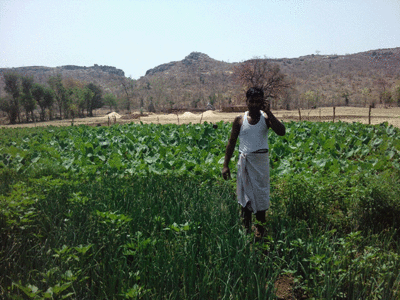- News
- Here, they go against the grain
This story is from May 1, 2016
Here, they go against the grain
In parched Bundelkhand in Madhya Pradesh, villagers in Dargai Khurd and Gour have devised clever ways to recycle water — they bathe on coir cots and place a vessel beneath to collect the water draining down.

In parched Bundelkhand in Madhya Pradesh, villagers in Dargai Khurd and Gour have devised clever ways to recycle water — they bathe on coir cots and place a vessel beneath to collect the water draining down.
In parched Bundelkhand in Madhya Pradesh, villagers in Dargai Khurd and Gour have devised clever ways to recycle water — they bathe on coir cots and place a vessel beneath to collect the water draining down. This will later be used to wash clothes and utensils. Six kilometres farther down in Gayajeetpura, a bath can thankfully still be had without resorting to such extreme economy.
This village of 700 in Tikamgarh — the worst drought-affected district in the region — has managed to steer clear of troubled waters by reforming its farming practices.Up until three years ago, the village grew water-guzzling wheat and soyabean like its neighbours and found its yield dropping along with the water level of the local 13th century Chandela-era Kumhedi lake, which was down to 10 feet of water. While the advantageous location of the village — in the downstream of the lake — ensured that it was not as deprived as nearby villages, its depleting water table also served as a caution. After all, 900 water bodies built by the Chandela rulers between the 10th and 13th century are now bone-dry in the region.
So three years ago, Gayajeetpura acted on the advice of a non-profit and replaced a part of their crop share with organic horticulture. “It’s how we managed to face Tikamgarh’s third successive drought,” says Rajendra Prasad, a Dalit farmer, who has been sowing vegetables for the last two years on part of his 3-acre plot. While the fields of neighbouring Mohangarh tehsil are scorched, Prasad’s fields, along with those of 20 other farmers in Gayajeetpura, are lush green.
“We have not only shifted partially from wheat and soyabean to vegetables and fruit like papaya, but we’ve also started optimizing our use of water,” he says.
How they did it:
* Shifted to organic horticulture which fetches higher prices
* Adopted contour farming on slopes to conserve water
This village of 700 in Tikamgarh — the worst drought-affected district in the region — has managed to steer clear of troubled waters by reforming its farming practices.Up until three years ago, the village grew water-guzzling wheat and soyabean like its neighbours and found its yield dropping along with the water level of the local 13th century Chandela-era Kumhedi lake, which was down to 10 feet of water. While the advantageous location of the village — in the downstream of the lake — ensured that it was not as deprived as nearby villages, its depleting water table also served as a caution. After all, 900 water bodies built by the Chandela rulers between the 10th and 13th century are now bone-dry in the region.
So three years ago, Gayajeetpura acted on the advice of a non-profit and replaced a part of their crop share with organic horticulture. “It’s how we managed to face Tikamgarh’s third successive drought,” says Rajendra Prasad, a Dalit farmer, who has been sowing vegetables for the last two years on part of his 3-acre plot. While the fields of neighbouring Mohangarh tehsil are scorched, Prasad’s fields, along with those of 20 other farmers in Gayajeetpura, are lush green.
“We have not only shifted partially from wheat and soyabean to vegetables and fruit like papaya, but we’ve also started optimizing our use of water,” he says.
The farmers here have created small slopes on their fields and planted vegetables in close rows on these slopes so that water trickles down and covers a wider area. Nandram, another farmer, grows papaya, tomato, onion, chilli, lady finger and cucumber and earns between Rs 500 and Rs 1,000 a week at the weekly market.
How they did it:
* Shifted to organic horticulture which fetches higher prices
* Adopted contour farming on slopes to conserve water
End of Article
FOLLOW US ON SOCIAL MEDIA
